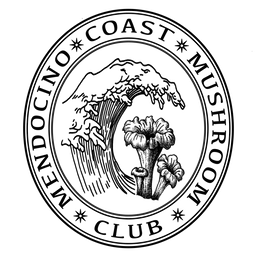Amanitas of North America by By Britt Bunyard and Jay Justice
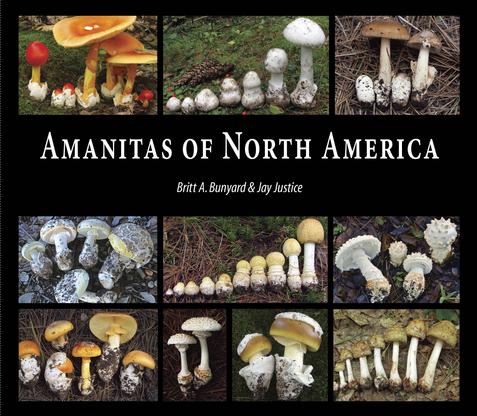
This book was recommended by Tom Jelen.
Discover the Amanitas of North America! Amanitas arguably are the most recognized and fascinating of all mushrooms. Amanita species mostly are big and showy, and ubiquitous over most of the planet wherever terrestrial plants grow.
Amanitas of North America features images and descriptions of more than 120 species and species groups of Amanitas found in North America. Along with the most commonly seen species, rare or poorly known Amanita species are included.
Amanitas of North America is the first-ever complete reference for mushroom hunters and mycophiles, citizen scientists, and academics mycologists. Each species profile includes basic information on where and when this species is known to occur, ecology, edibility/toxicology, etymology, and detailed information on macro- and micro-morphology characters. And every species described is depicted with stunning photography. 340 pages, with over 350 color photographs.
Available for purchase at Fungi Magazine online store
Discover the Amanitas of North America! Amanitas arguably are the most recognized and fascinating of all mushrooms. Amanita species mostly are big and showy, and ubiquitous over most of the planet wherever terrestrial plants grow.
Amanitas of North America features images and descriptions of more than 120 species and species groups of Amanitas found in North America. Along with the most commonly seen species, rare or poorly known Amanita species are included.
Amanitas of North America is the first-ever complete reference for mushroom hunters and mycophiles, citizen scientists, and academics mycologists. Each species profile includes basic information on where and when this species is known to occur, ecology, edibility/toxicology, etymology, and detailed information on macro- and micro-morphology characters. And every species described is depicted with stunning photography. 340 pages, with over 350 color photographs.
Available for purchase at Fungi Magazine online store
Mushrooms for Dyes, Paper, Pigments & Myco-Stix™ by Miriam C. Rice, Illustrations by Dorothy M. Beebee

This book was recommended by Nancy Denison.
This book details the history, development, and science of mushroom arts. It both tells and shows how to extract substances from mushrooms that allow an artist to make textile dyes, paper sculpture or plain paper, watercolors and crayons for drawing. Beebee’s pen and ink drawings appear throughout and color photos of mushroom arts accompany each section. Always eager to expand her knowledge of what she might find in natural substances, Rice devised a way to turn mushroom-extracted pigments into drawing tools, the result being her invention and development of “Myco-Stix™”. This book introduces this new drawing tool to artists everywhere. Mushrooms for Dyes, Paper, Pigments & Myco-Stix™ will delight, instruct, and inspire seasoned artists and newcomers alike. 162 pages, softcover. $36.95
Available for purchase at Fungi Perfecti
This book details the history, development, and science of mushroom arts. It both tells and shows how to extract substances from mushrooms that allow an artist to make textile dyes, paper sculpture or plain paper, watercolors and crayons for drawing. Beebee’s pen and ink drawings appear throughout and color photos of mushroom arts accompany each section. Always eager to expand her knowledge of what she might find in natural substances, Rice devised a way to turn mushroom-extracted pigments into drawing tools, the result being her invention and development of “Myco-Stix™”. This book introduces this new drawing tool to artists everywhere. Mushrooms for Dyes, Paper, Pigments & Myco-Stix™ will delight, instruct, and inspire seasoned artists and newcomers alike. 162 pages, softcover. $36.95
Available for purchase at Fungi Perfecti
The Mushroom Hunters: On the Trail of an Underground America by Langdon Cook

This book was recommended by Eric Schramm at the February 18th, 2019 meeting of the MCMC.
Reviews are in: Publishers Weekly finds it “intrepid and inspired.”
The Wall Street Journal calls it a “rollicking narrative…delivering vivid and cinematic scenes on every page.”
Amazon.com picked it as one of the Best Books of the Year.
The Seattle Times says:
Like Susan Orlean in “The Orchid Thief,” Seattle author Cook shines a light on a shady subculture operating at the seam between wilderness and commerce. Like author Michael Pollan, he knows that every bite of food these days has a complex, often unsavory backstory. Like the late Hunter Thompson, he not only goes along for the ride with the shifty characters he’s writing about, but drives the getaway car.
Here’s a quote from a Library Journal review: Not simply about mushrooms, this book examines human behavior, economics, food, society, and nature. In the end, readers will have learned a great deal about U.S. economic and social structures—all while being entertained and enlightened by stories of gastronomy and mushrooms. Highly recommended.
Reviews are in: Publishers Weekly finds it “intrepid and inspired.”
The Wall Street Journal calls it a “rollicking narrative…delivering vivid and cinematic scenes on every page.”
Amazon.com picked it as one of the Best Books of the Year.
The Seattle Times says:
Like Susan Orlean in “The Orchid Thief,” Seattle author Cook shines a light on a shady subculture operating at the seam between wilderness and commerce. Like author Michael Pollan, he knows that every bite of food these days has a complex, often unsavory backstory. Like the late Hunter Thompson, he not only goes along for the ride with the shifty characters he’s writing about, but drives the getaway car.
Here’s a quote from a Library Journal review: Not simply about mushrooms, this book examines human behavior, economics, food, society, and nature. In the end, readers will have learned a great deal about U.S. economic and social structures—all while being entertained and enlightened by stories of gastronomy and mushrooms. Highly recommended.
A Victorian Naturalist: Beatrix Potter's Drawings from the Armitt Collection by Eileen Jay; Mary Noble; Anne Stevenson Hobbs
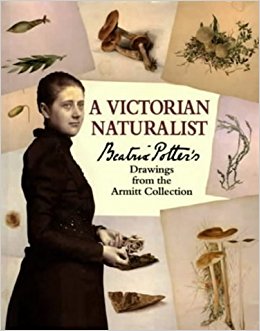
This book was recommended by Pat Ferrero at the February 12th, 2018 meeting of the MCMC.
One of the most unusual collections of Beatrix Potter's art is held by a small trust at the Armitt Library in Ambleside, Cumbria in the English Lake District. At this time she was already famous as the creator of Peter Rabbit, but the paintings she donated date from the period before she had begun to produce children's books and are on a very different subject. These studies of fossils, archaeological finds, mosses and lichens, microscope drawings and, most importantly, the exceptionally fine fungus paintings comprise a remarkable body of scientific illustration.
Few details had been known about Beatrix Potter's scientific work until the discovery by Dr. Mary Noble of a series of letters between Beatrix and Charles McIntosh, the celebrated Scottish naturalist. In this book Mary Noble has used the correspondence between the two to explain and annotate the paintings. The letters also reveal how Beatrix battled to have her work recognized by the authorities of the day. The humour and spirit with which the young Beatrix Potter 'took on' the male-dominated scientific establishment makes this a delightful story, told here in its entirety for the first time.
One of the most unusual collections of Beatrix Potter's art is held by a small trust at the Armitt Library in Ambleside, Cumbria in the English Lake District. At this time she was already famous as the creator of Peter Rabbit, but the paintings she donated date from the period before she had begun to produce children's books and are on a very different subject. These studies of fossils, archaeological finds, mosses and lichens, microscope drawings and, most importantly, the exceptionally fine fungus paintings comprise a remarkable body of scientific illustration.
Few details had been known about Beatrix Potter's scientific work until the discovery by Dr. Mary Noble of a series of letters between Beatrix and Charles McIntosh, the celebrated Scottish naturalist. In this book Mary Noble has used the correspondence between the two to explain and annotate the paintings. The letters also reveal how Beatrix battled to have her work recognized by the authorities of the day. The humour and spirit with which the young Beatrix Potter 'took on' the male-dominated scientific establishment makes this a delightful story, told here in its entirety for the first time.
The Mushroom at the End of the World
On the Possibility of Life in Capitalist Ruins by Anna Lowenhaupt Tsing
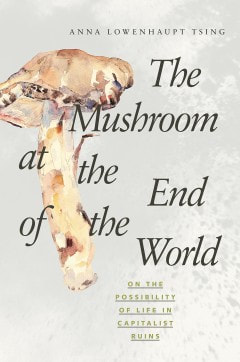
This book was recommended by Pat Ferrero at the February 12th, 2018 meeting of the MCMC.
Matsutake is the most valuable mushroom in the world—and a weed that grows in human-disturbed forests across the northern hemisphere. Through its ability to nurture trees, matsutake helps forests to grow in daunting places. It is also an edible delicacy in Japan, where it sometimes commands astronomical prices. In all its contradictions, matsutake offers insights into areas far beyond just mushrooms and addresses a crucial question: what manages to live in the ruins we have made?
A tale of diversity within our damaged landscapes, The Mushroom at the End of the World follows one of the strangest commodity chains of our times to explore the unexpected corners of capitalism. Here, we witness the varied and peculiar worlds of matsutake commerce: the worlds of Japanese gourmets, capitalist traders, Hmong jungle fighters, industrial forests, Yi Chinese goat herders, Finnish nature guides, and more. These companions also lead us into fungal ecologies and forest histories to better understand the promise of cohabitation in a time of massive human destruction.
By investigating one of the world's most sought-after fungi, The Mushroom at the End of the World presents an original examination into the relation between capitalist destruction and collaborative survival within multispecies landscapes, the prerequisite for continuing life on earth.
Anna Lowenhaupt Tsing is professor of anthropology at the University of California, Santa Cruz, and a Niels Bohr Professor at Aarhus University in Denmark, where she codirects Aarhus University Research on the Anthropocene (AURA). She is the author of Friction and In the Realm of the Diamond Queen (both Princeton).
Matsutake is the most valuable mushroom in the world—and a weed that grows in human-disturbed forests across the northern hemisphere. Through its ability to nurture trees, matsutake helps forests to grow in daunting places. It is also an edible delicacy in Japan, where it sometimes commands astronomical prices. In all its contradictions, matsutake offers insights into areas far beyond just mushrooms and addresses a crucial question: what manages to live in the ruins we have made?
A tale of diversity within our damaged landscapes, The Mushroom at the End of the World follows one of the strangest commodity chains of our times to explore the unexpected corners of capitalism. Here, we witness the varied and peculiar worlds of matsutake commerce: the worlds of Japanese gourmets, capitalist traders, Hmong jungle fighters, industrial forests, Yi Chinese goat herders, Finnish nature guides, and more. These companions also lead us into fungal ecologies and forest histories to better understand the promise of cohabitation in a time of massive human destruction.
By investigating one of the world's most sought-after fungi, The Mushroom at the End of the World presents an original examination into the relation between capitalist destruction and collaborative survival within multispecies landscapes, the prerequisite for continuing life on earth.
Anna Lowenhaupt Tsing is professor of anthropology at the University of California, Santa Cruz, and a Niels Bohr Professor at Aarhus University in Denmark, where she codirects Aarhus University Research on the Anthropocene (AURA). She is the author of Friction and In the Realm of the Diamond Queen (both Princeton).
Mycophilia: Revelations from the Weird World of Mushrooms by Eugenia Bone
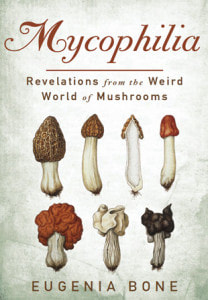
This book was recommended by Eric Schramm at the January 30th, 2018 meeting of the MCMC. Her Mycophilia website contains a great mushroom primer along with numerous recipes.
In Mycophilia, accomplished food writer and cookbook author Eugenia Bone examines the role of fungi as exotic delicacy, curative, poison, and hallucinogen, and ultimately discovers that a greater understanding of fungi is key to facing challenges of the 21st century.
Whether one's interest in mushrooms is culinary, scientific, recreational, or entrepreneurial, Mycophiliawill open a reader's eyes to the vast and bizarre world of fungi and their role in the deeply complex yet profoundly graceful interplay of life on earth.
In Mycophilia, accomplished food writer and cookbook author Eugenia Bone examines the role of fungi as exotic delicacy, curative, poison, and hallucinogen, and ultimately discovers that a greater understanding of fungi is key to facing challenges of the 21st century.
Whether one's interest in mushrooms is culinary, scientific, recreational, or entrepreneurial, Mycophiliawill open a reader's eyes to the vast and bizarre world of fungi and their role in the deeply complex yet profoundly graceful interplay of life on earth.
MUSHROOMS: A NATURAL AND CULTURAL HISTORY by Nicholas P. Money
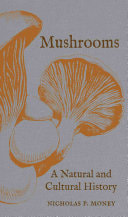
This book was recommended by Mario Abreu at the January 30th, 2018 meeting of the MCMC. Mario found it to be humorous, scientific and a very easy read.
Mushrooms are loved, despised, feared, and misunderstood; they occupy a special place in human consciousness, embedded in childhood through fairy tales, movies, and video games. This book introduces mushroom mythology and science, the history of our interactions with these fungi, and the ways that humans use mushrooms as food, medicines, and recreational drugs. The natural history is supplemented with profiles of the mycologists who advanced the study of the fungi. As paragons of eccentricity, these individuals are peerless
Mushrooms are loved, despised, feared, and misunderstood; they occupy a special place in human consciousness, embedded in childhood through fairy tales, movies, and video games. This book introduces mushroom mythology and science, the history of our interactions with these fungi, and the ways that humans use mushrooms as food, medicines, and recreational drugs. The natural history is supplemented with profiles of the mycologists who advanced the study of the fungi. As paragons of eccentricity, these individuals are peerless
Mushrooms of the Redwood Coast by Noah Siegel and Christian Schwarz
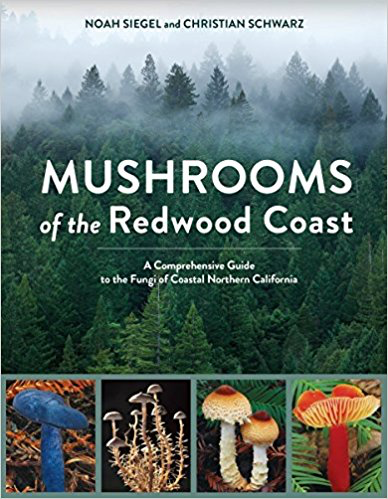
At the November 10th, 2016 Club meeting and dinner, Noah gave a lecture and introduced the club to the new book.
Mushrooms of the Redwood Coast helps beginning and experienced mushroom hunters alike find and identify mushrooms. Common and conspicuous species, delicious edibles, toxic and deadly species, and distinctive rarities are all covered in this user-friendly reference, which covers the diversity found in coastal California from Monterey County to the Oregon border. With full treatments of more than 750 species, and references to hundreds more, tips on mushroom collecting, descriptions of specific habitats and bio-zones, updated taxonomy, and stunning photography, this book is the most modern and comprehensive guide to mushrooms in the region. Each species profile pairs a photograph with an in-depth description, as well as notes on ecology, edibility, toxicity, and look-alike species. Mushrooms of the Redwood Coast is an indispensable book for anyone curious about fungi.
A spreadsheet of all the name changes that have occurred since the printing of Mushrooms of the Redwood Coast can be found here: MoRC Nomenclatural Changes (last updated 26 February 2018)
Mushrooms of the Redwood Coast helps beginning and experienced mushroom hunters alike find and identify mushrooms. Common and conspicuous species, delicious edibles, toxic and deadly species, and distinctive rarities are all covered in this user-friendly reference, which covers the diversity found in coastal California from Monterey County to the Oregon border. With full treatments of more than 750 species, and references to hundreds more, tips on mushroom collecting, descriptions of specific habitats and bio-zones, updated taxonomy, and stunning photography, this book is the most modern and comprehensive guide to mushrooms in the region. Each species profile pairs a photograph with an in-depth description, as well as notes on ecology, edibility, toxicity, and look-alike species. Mushrooms of the Redwood Coast is an indispensable book for anyone curious about fungi.
A spreadsheet of all the name changes that have occurred since the printing of Mushrooms of the Redwood Coast can be found here: MoRC Nomenclatural Changes (last updated 26 February 2018)
